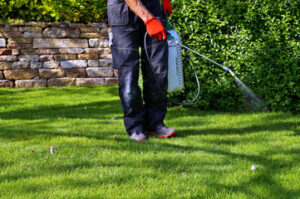How Pest Control Supports Health and Safety
Pest infestations can damage a business and require costly cleanup. Rapid response to pest problems interrupts reproduction and prevents infestations from worsening. Pest control procedures kill or remove the pests, and may include advice on eliminating conditions that attract them.

Control methods are divided into natural, biological, chemical, and cultural/physical. Each controls pest populations by limiting their access to food, water, and shelter. Contact Pest Control Trophy Club TX for professional help.
Identifying pests is the first step in developing a pest management plan. This allows us to determine basic information about the pest, such as its life cycle and damage potential, so that we can select appropriate control tactics. It also helps us decide whether or not the pest needs to be controlled at all, and if so, at what level.
In general, it is best to only control a pest when its numbers reach or exceed a threshold. Using a threshold approach prevents the use of excessive quantities of chemicals and conserves natural resources. This is an important aspect of IPM, which stresses the reduction or elimination of pesticides wherever possible.
When identifying pests it is always good to be able to distinguish the species, particularly for insect pests. This is because species within the same order or family often have different behavior and life history characteristics. It is also necessary for accurate identification to be able to select an approved insecticide when pest control is required.
A number of pest identification tools are available for scouting and trapping. Some are free, while others can be purchased at sporting goods stores and garden centers. Most of the more advanced tools require specialized training to use. A basic tool is a simple microscope with a magnifying lens and eyepiece. Other advanced tools are computer-based identification programs, digital imaging systems, and molecular diagnostics. PPQ’s Remote Pest Identification Program uses these methods to capture detailed images of intercepted organisms and transmit them electronically for identification by national specialists.
While experts can make an identification based on a digital image, it is best to have an actual specimen for confirmation. It is recommended to start a collection of labelled digital images by year, season and crop as a reference for future identifications. In addition, many land grant university extension services and IPM programs offer field guides for particular crops that contain excellent pictures of insect pests and their damage. Lastly, many commercial pesticide companies have websites that provide recommended resource for pest identification and other technical information.
Prevention
As the Dutch philosopher Desiderius Erasmus once said, “prevention is better than cure.” And when it comes to pest control, prevention is more effective and less costly than dealing with a full-blown infestation. Preventative measures focus on preventing pests from entering living spaces and – in the case of existing pests – keeping them from spreading. This can be done through a variety of strategies and treatments, from sealing cracks and gaps to maintaining cleanliness to removing food and water sources.
Prevention is especially important when it comes to pests that pose a threat to human health or property. Rodents like mice and rats spread dangerous diseases, while insects like cockroaches and mosquitoes can carry or trigger illnesses such as asthma, West Nile virus, malaria, and even the Zika virus. Pests that damage property can also be a major financial burden. For example, termite infestations can cost thousands of dollars to repair, while ant and bee colonies can create a sticky mess that’s difficult to clean up.
Pests can multiply rapidly, and failing to intervene in time can cause a population explosion that’s hard to control. Rapid pest treatment procedures can break the reproduction cycle and prevent an infestation from escalating. They can also protect valuable belongings, such as books, fabrics, and wooden items, by destroying the pests that would otherwise ruin them.
For businesses involved in food processing or storage, preventative pest management is a crucial part of meeting strict health and safety standards. Food-related pests can contaminate supplies, leading to serious illness, and preventative pest control measures can ensure the safety of both staff and customers.
Prevention is also essential for public and commercial facilities such as schools, libraries, and museums that rely on visitors. Insects and rodents that are able to enter these establishments can cause harm to the building itself and damage its collections. Preventative measures such as educating visitors about pest behavior and providing prompt reporting can help address pest issues before they escalate.
Treatment
Pest control uses preventive methods to stop pests from invading your property, as well as treatments that use insecticides and physical traps to address existing infestations. In addition to providing peace of mind and preserving your home’s value, pest control services also help protect your health by eliminating harmful pathogens and allergens that pests can carry.
A combination of prevention and treatment is the most effective way to manage unwanted pests around your home. While pest control tips and traps can prevent them from entering your home in the first place, a professional inspection and targeted treatments will remove them once they’re already inside.
While it can be unsettling to see an increase in pest activity immediately after a treatment, this is normal and a sign that the pest control measures are working. The increased sightings typically last from a few days to a couple of weeks, as the pests move around in search of new hiding places. Once they come into contact with the treatment and die, their numbers should decrease gradually.
It’s important to avoid re-cleaning your kitchen cabinets and other areas within a week after your pest control service, as this can rubbed off the chemicals before they have time to take effect. You may also want to avoid cleaning up food crumbs and paper trash, as these can attract pests that haven’t yet been exposed to the treatment.
You should also store or put away all foods, plates, utensils, bowls, and cups until after the treatment, as these items can be contaminated with pest control chemicals. It’s best to keep them in airtight containers, such as the fridge and pantry, or in the garage or shed if necessary.
It’s also worth noting that the duration of a pest control treatment will vary depending on the pests you’re trying to eliminate, your climate, and the specific type of treatment used. In general, treatments that eliminate flying insects like flies and mosquitoes will only be effective for about 30 days, while others will last up to 90 days or longer.
Monitoring
Pest monitoring is essential for effective integrated pest management (IPM). Regular analysis of monitoring data helps identify trends and patterns, and informs pest control decisions. It is also critical in identifying pest thresholds and action levels that guide treatment decisions and prevent economic damage.
Proper scouting methods can help with this process. This includes inspecting incoming plant material for pests, random and indicator plants in the field, and the use of sticky traps and other methods to sample insects. In addition to assisting in the identification of pests, sampling techniques can also aid in the evaluation of current treatments, as well as their effectiveness.
Using the right tools can make all the difference. Tools such as a flashlight and an extendable mirror help inspectors examine secluded areas for potential hiding spots, maintenance needs, sanitation deficiencies, and other issues. Other helpful tools include a magnifying glass to verify the presence of insect parts, frass (excrement), and other evidence of pest activity. A tape measure and a hand-held scale are also useful for determining the size of pests and other important information.
Other important tools for a PCO are insect monitoring traps, scouting equipment, and digital monitoring and reporting tools. Using the right baits and traps in the correct locations can help minimize pest populations by targeting key habitats and feeding areas. The use of monitoring traps can allow a PCO to accurately evaluate pest population levels, reducing the need for excessive or ineffective chemical treatments.
The ability to capture data remotely with digital monitoring systems can be an asset for any pest control business. The ServSuite app by ServicePro offers pest control companies with remote monitoring capabilities that alert them when their traps, cages and snap traps are triggered. This allows a PCO to respond quickly and efficiently, minimizing rodent intrusions and eliminating unnecessary treatment. This technology can also help a PCO better understand the habits of rodents and other pests, and determine how to modify their exclusion strategies accordingly. This is a vital step toward more efficient operations, reduced labor costs and improved customer satisfaction.
